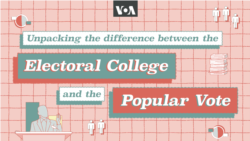ປະຊາຊົນຊາວອາເມຣິກັນ ໄດ້ໄປລົງຄະແນນສຽງໃນວັນທີ 5 ພະຈິກວານນີ້ ເພື່ອເລືອກເອົາປະທານາທິບໍດີສະຫະລັດຄົນຕໍ່ໄປ. ແນວໃດກໍຕາມ, ຄະແນນສຽງທົ່ວປະເທດບໍ່ໄດ້ກຳນົດວ່າຜູ້ສະໝັກຮັບເລືອກຕັ້ງຄົນໃດຈະໄດ້ຄອບຄອງທຳນຽບຂາວ. ຄະແນນສຽງຜູ້ແທນລັດ ຫຼື Electoral College ມີອຳນາດໃນການຕັດສິນຂັ້ນສຸດທ້າຍ. ແຕ່ລະບົບນີ້ດຳເນີນການແນວໃດ?
ເມື່ອຜູ້ສະໝັກຮັບເລືອກຕັ້ງ ຊະນະຄະແນນປະຊານິຍົມ, ມັນຫມາຍຄວາມວ່າພວກເຂົາໄດ້ຮັບຄະແນນ ສຽງໂດຍລວມ ຫຼາຍກວ່າຄູ່ແຂ່ງຂອງພວກເຂົາ.
ແຕ່ນີ້ບໍ່ແມ່ນວິທີການເລືອກປະທານາທິບໍດີຂອງ ສະຫະລັດ.
ໃນເວລາທີ່ບັນດາຜູ້ກໍ່ຕັ້ງປະເທດຂອງອາເມຣິກາ ໄດ້ກຳນົດຂະບວນການເລືອກຕັ້ງຂຶ້ນໃນປີ 1787, ພວກເຂົາຕ້ອງການສ້າງຄວາມດຸ່ນດ່ຽງຂອງອຳນາດລະຫວ່າງລັດຕ່າງໆ ແລະປ້ອງກັນບໍ່ໃຫ້ຜູ້ສະຫມັກ ທີ່ບໍ່ມີຄວາມເຫມາະສົມ ເຂົ້າຮັບຕໍາແຫນ່ງ.
ຄະແນນສຽງຜູ້ແທນຂອງລັດ ໄດ້ຖືກສ້າງຂຶ້ນເພື່ອເປັນການຜ່ອນຜັນ, ໂດຍເຮັດຫນ້າທີ່ເປັນໂຕຮັບ ແຮງສະທ້ອນລະຫວ່າງການເລືອກຕັ້ງ ແລະການແຕ່ງຕັ້ງປະທານາທິບໍດີ.
ປະຈຸບັນຄະແນນສຽງຜູ້ແທນຂອງລັດ ມີຜູ້ແທນ 538 ທ່ານ, ແຈກຢາຍຢູ່ໃນທັງຫມົດ 50 ລັດຂອງ ສະຫະລັດ ໂດຍອີງຕາມຂະຫນາດຂອງຄະນະຜູ້ແທນລັດຖະສະພາຂອງລັດ, ເຊິ່ງຂຶ້ນກັບຈຳນວນ ປະຊາກອນເປັນສ່ວນໃຫຍ່, ຕົວຢ່າງເຊັ່ນ, ລັດຄາລິຟໍເນຍ, ມີຄະແນນສຽງຜູ້ແທນລັດ 54 ຄົນ, ໃນຂະນະທີ່ ລັດ ໄວໂອມິງ (Wyoming) ທີ່ມີປະຊາກອນຫນ້ອຍ, ມີພຽງແຕ່ 3 ຄົນ.
ໃນການຈະໄດ້ເປັນປະທານາທິບໍດີ, ຜູ້ສະຫມັກຈະຕ້ອງໄດ້ຄະແນນສຽງຂອງຄະນະຜູ້ແທນລັດ ຢ່າງຫນ້ອຍ 270 ຄະແນນສຽງ ຈາກທັງໝົດ 538 ສຽງ.
ມີ 48 ລັດ ແລະ ນະຄອນຫຼວງ ວໍຊິງຕັນ ທີ່ໃຊ້ລະບົບຜູ້ຊະນະໄດ້ຮັບຄະແນນສຽງທັງໝົດ, ດັ່ງນັ້ນ, ຜູ້ຖືກສະເໜີຊື່ລົງແຂ່ງຂັນເອົາຕໍາແໜ່ງປະທານາທິບໍດີທີ່ມີຄະແນນສຽງຫຼາຍທີ່ສຸດໃນລັດນັ້ນ ຈະໄດ້ ຮັບຄະແນນສຽງຂອງຄະນະຜູ້ແທນລັດທັງໝົດ.
ມີ 2 ລັດ ຄື ລັດເມນ (Maine) ແລະ ລັດ ເນບຣາສກາ (Nebraska) ທີ່ຈັດສັນຄະແນນສຽງຂອງ ຄະນະຜູ້ແທນລັດບາງສ່ວນ ໃຫ້ຜູ້ສະຫມັກທີ່ມີຄະແນນສຽງຫຼາຍທີ່ສຸດໃນແຕ່ລະເຂດເລືອກຕັ້ງ, ດັ່ງນັ້ນ, ຜົນໄດ້ຮັບຈຶ່ງສາມາດແບ່ງອອກໄດ້.
ເມື່ອເວົ້າກ່ຽວກັບຜົນໄດ້ຮັບຂອງການເລືອກຕັ້ງຂອງສະຫະລັດ, ການລົງຄະແນນສຽງໃນທົ່ວປະເທດ ແມ່ນບໍ່ມີຄວາມສຳຄັນ. ມັນເປັນໄປໄດ້ທີ່ຈະເປັນປະທານາທິບໍດີ ເຖິງແມ່ນວ່າຈະມີຄະແນນນິຍົມຫນ້ອຍ ກວ່າຜູ້ສະຫມັກຄົນອື່ນກໍຕາມ.
ເຫດການນີ້ໄດ້ເກີດຂຶ້ນມາແລ້ວ 5 ຄັ້ງໃນປະຫວັດສາດ.
ທ່ານ ດໍໂນລ ທຣໍາ ໄດ້ເປັນປະທານາທິບໍດີໃນປີ 2016 ເຖິງແມ່ນວ່າຈະໄດ້ຮັບຄະແນນສຽງໜ້ອຍກວ່າ ທ່່ານນາງ ຮິລລາຣີ ຄລີນຕັນ (Hillary Clinton) 2.9 ລ້ານຄະແນນສຽງ ກໍຕາມ. ທ່ານ ຈອດຈ໌ ດັບເບີລຢູ. ບູຊ (George W. Bush) ໄດ້ຊະນະການເລືອກຕັ້ງປະທານາທິບໍດີ ໃນປີ 2000 ເຖິງ ແມ່ນວ່າຈະໄດ້ຮັບຄະແນນສຽງໜ້ອຍກວ່າ ທ່ານ ອັລ ກໍ (Al Gore) ເຖິງ 540,000 ສຽງກໍຕາມ.
ຂະບວນການ "ການເລືອກຕັ້ງທາງອ້ອມ" ຂອງອາເມຣິກາ ຍັງສືບຕໍ່ປະເຊີນກັບການກວດກາ. ມີຂໍ້ສະເໜີໃຫ້ຍົກເລີກ ຫຼືປະຕິຮູບຄະນະແນນສຽງຂອງຄະນະຜູ້ແທນລັດ ຫຼາຍກວ່າ 700 ຄັ້ງ, ແຕ່ກໍບໍ່ມີອັນໃດປະສົບຜົນສຳເລັດ.
ພວກເຮົາຄົງຈະຮູ້ຊື່ປະທານາທິບໍດີຄົນຕໍ່ໄປໃນອີກບໍ່ດົນຫຼັງວັນເລືອກຕັ້ງ, ແຕ່ສະມາຊິກຄະນະຜູ້ແທນຈາກແຕ່ລະລັດ ຈະບໍ່ລົງຄະແນນສຽງຢ່າງເປັນທາງການຈົນກວ່າຈະຮອດເດືອນທັນວາ.
ເຖິງແມ່ນວ່າຂະບວນການຂອງຄະແນນສຽງຄະນະຜູ້ແທນລັດ ຈະຖືກຂຽນໄວ້ໃນລັດຖະທໍາມະນູນກໍຕາມ, ແຕ່ມັນກໍບໍ່ໄດ້ລະບຸວ່າສະມາຊິກຂອງຄະນະຜູ້ແທນ ຈະຕ້ອງລົງຄະແນນສຽງໃຫ້ສອດຄ່ອງກັບຜູ້ລົງຄະແນນ ຂອງລັດ. ນັ້ນ, ເປັນໜ້າທີ່ຂອງແຕ່ລະລັດທີ່ຈະກຳນົດອອກມາ.
ມາຮອດປະຈຸບັນນີ້, ສະມາຊິກຄະນະຜູ້ແທນທີ່ "ບໍ່ໄວ້ວາງໃຈ" 90 ທ່ານ, ໄດ້ລົງຄະແນນສຽງໃຫ້ຜູ້ສະໝັກ ເອົາຕໍາແໜ່ງປະທານາທິບໍດີຄົນອື່ນ, ເຖິງແມ່ນວ່າຈະມີພຽງທ່ານດຽວເທົ່ານັ້ນ ທີ່ເຄີຍລົງຄະແນນສຽງໃຫ້ຜູ້ສະໝັກຂອງພັກທີ່ຜ່າຍແພ້ການເລືອກຕັ້ງ ໃນການເລືອກຕັ້ງທີ່ສູສີກັນ. ເຊິ່ງນີ້ ບໍ່ເຄີຍເຮັດໃຫ້ການເລືອກຕັ້ງ ຕ່າວປີ້ນໄດ້, ແຕ່ມັນສະແດງໃຫ້ເຫັນເຖິງຄວາມບໍ່ແນ່ນອນຂອງລະບົບການເລືອກຕັ້ງຂອງ ອາເມຣິກາ.
ອ່ານລາຍງານນີ້ເປັນພາສາອັງກິດ
Americans go to the polls November 5 to choose the next U.S. president. However, the national vote tally does not determine which candidate wins the White House. The Electoral College has the final say. But how does this work?
When candidates win the popular vote, it means they’ve secured more total votes than their opponent.
But this isn’t how the U.S. president is chosen.
When America’s Founding Fathers established electoral processes in 1787, they wanted to balance the power between states and prevent unfit candidates from assuming the office.
The Electoral College was created as a compromise, acting as a buffer between elections and presidential appointments.
The Electoral College currently has 538 electors, distributed among all 50 U.S. states based on the size of their congressional delegations, which in turn is based mainly on population. California, for example, has 54 electors, while sparsely populated Wyoming has only three.
To become president, a candidate needs at least 270 electoral college votes out of 538.
Forty-eight states and the District of Columbia have a winner-takes-all system, so the presidential nominee with the most votes in that state receives all the electoral votes.
Two states — Maine and Nebraska — allocate some electoral votes to the candidate with the most votes in each congressional district, so the outcome can be split.
When it comes to the outcome of the U.S. election, the nationwide popular vote doesn’t matter. It’s possible to become president even with fewer popular votes than another candidate.
This has happened five times in history.
Donald Trump became president in 2016 despite receiving 2.9 million fewer votes than Hillary Clinton. George W. Bush won the White House in 2000 despite having 540,000 fewer votes than Al Gore.
America’s “indirect election” process continues to face scrutiny. There have been more than 700 proposals to abolish or reform the Electoral College, but none have succeeded.
We’ll probably know the next president shortly after election day, but electors from each state don’t formally vote until December.
Although the Electoral College process is written into the Constitution, it doesn’t say electors must vote in line with state voters. That’s left to the states to mandate.
Until now, 90 “faithless” electors have voted for a different presidential candidate, though only one ever voted for the losing party’s candidate in a close election. This has never swung an election, but it highlights the unpredictability of America’s electoral systems.






ຟໍຣັມສະແດງຄວາມຄິດເຫັນ